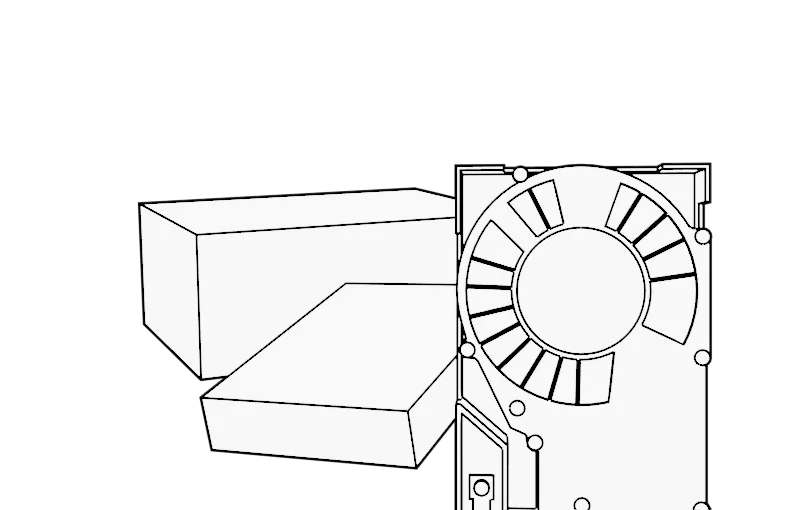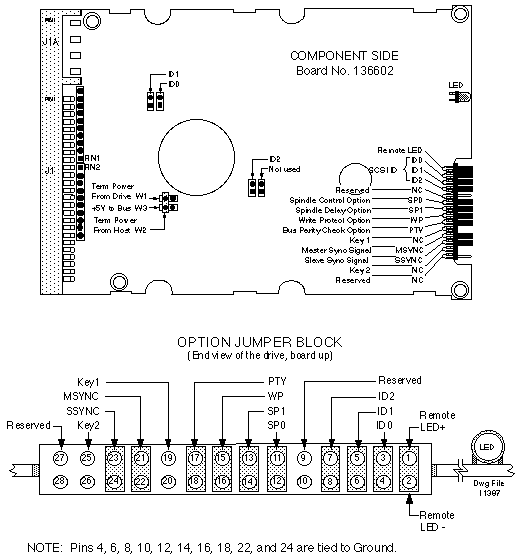DRIVE ADDRESSING AND INTERFACE TERMINATION
SCSI ADDRESS JUMPERS (ID0, ID1, ID2)
Up to eight devices (the host and seven targets) can be attached to the
SCSI bus at one time.
ID jumpers ID0, ID1, and ID2 are used to assign one of eight SCSI iID bits
(0-7) to the drive.
Note also that there are two jumper sets to set SCSI id settings,
one closer to the LED, the other in the middle of the board.
We do not preconfigure the block closest to the LED (default set to 0)
but do configure the middle block to SCSI id 7 (factory default configuration.
In multiple device systems, each drive must have its own unique SCSI ID.
| SCSI |
Jumpers |
| Address |
ID2 |
ID1 |
ID0 |
| ------- |
----- |
----- |
----- |
| 0 |
out |
out |
out |
| 1 |
out |
out |
in |
| 2 |
out |
in |
out |
| 3 |
out |
in |
in |
| 4 |
in |
out |
out |
| 5 |
in |
out |
in |
| 6 |
in |
in |
out |
| 7 (Default) |
in |
in |
in |
INTERFACE TERMINATOR (RN1, RN2)
The Interface Terminator factory installed at RN1 and RN2, which
provides proper termination for the interface lines. When
daisy-chaining multiple drives, leave the terminators installed
only in the last physical drive (or drives) on the daisy chain
cable; remove the terminating resistors from each of the other drives
(or the host computer).
BUS TERMINATION POWER OPTION (W1, W2, W3)
A jumper is installed at W1, at W2, or at W2 and W3 to select the
source of terminator power (+5V) for the SCSI Bus terminator packs on
the device electronics board.
When a jumper is installed at W1 (the factory default configuration),
the drive provides terminator power to it's on-board terminators, otherwise
known as local termination power.
When a jumper is installed at W2 , terminator power is is provided by
the host system via the interface cable J1, pin 26 (TERMPWR).
When a jumper is installed at both W1 and W3, the drive provides
terminator power to its on-board terminators and also to the SCSI bus
via interface cable J1, pin 26 (TERMPWR).
SPINDLE CONTROL OPTION
A jumper at SPIN0 is used to select the spindle control option.
When a jumper is installed, the drive must wait for an interface
START UNIT command to start the spindle motor.
When a jumper is NOT installed, (the factory default configuration),
the drive automatically starts the spindle motor at power-on.
SPINDLE DELAY OPTION
A jumper at SPIN1 is used to select the spindle delay option
(spindle start-up is delayed based upon the SCSI ID). Delay time
per ID is 12 seconds.
When a jumper is installed, spindle delay is enabled.
When a jumper is NOT installed, (the factory default configuration),
spindle delay is disabled.
BUS PARITY OPTION
A jumper at PTY is used to select parity check option.
When a jumper is installed, the drive neither generates nor detects parity.
When a jumper is not installed (the factory default configuration), the drive
generates parity and has parity detection enabled.
WRITE PROTECT OPTION
A jumper at WP is used to write protect the drive. Please note that the
When a jumper is installed, the drive is write protected.
When a jumper is not installed (factory default configuration), data can be
written to the drive (
REMOTE LED SELECTOR
When a remote LED is connected to the LED jumper, both LEDs (On device
electronics boards and remote location) are enabled.
When a remote LED is not connected to the LED jumper, only the device
electronics board LED is enabled.
SPINDLE SYNCHRONIZATION OPTION
Jumpers installed at W10 and W11 provide termination for the Spindle
Synchronization signals (Slave Sync and Master Sync respectively).
When Spindle Synchronization is to be implemented, jumpers W10 and W11
are removed from all drives except the last drive on the cable.
The Rotational Position Locking field (MODE SELECT command, Page Code
04h) is used to specify spindle synchronization operation; see
document #110366(Scsi Implementation in Micropolis "MZR" Products) and
ANSI-2 SCSI Standard.
Unsynchronized: If the drive is set to Unsynchronized (PRL=00b), it
ignores the SLAVE SYNC signal.
Slave: If the drive is set to Slave (RPL=01b), it does not generate the
MASTER SYNC signal or the SLAVE SYNC signal but synchronizes its
index to the SLAVE SYNC signal (J2,pin 20) supplied by an external
source.
Master: If the drive is set to MASTER (RPL=10b), it generates the SLAVE
SYNC output signal (j2,pin 20) for use directly by the slave drives.
Master Control: If the drive is set to Master Control (RPL=11b), it
generates the MASTER SYNC signal(j2,pin 20). This output
is used by the controller to generate the SLAVE SYNC
signal(J2,pin 20) for the slave drives.
|

